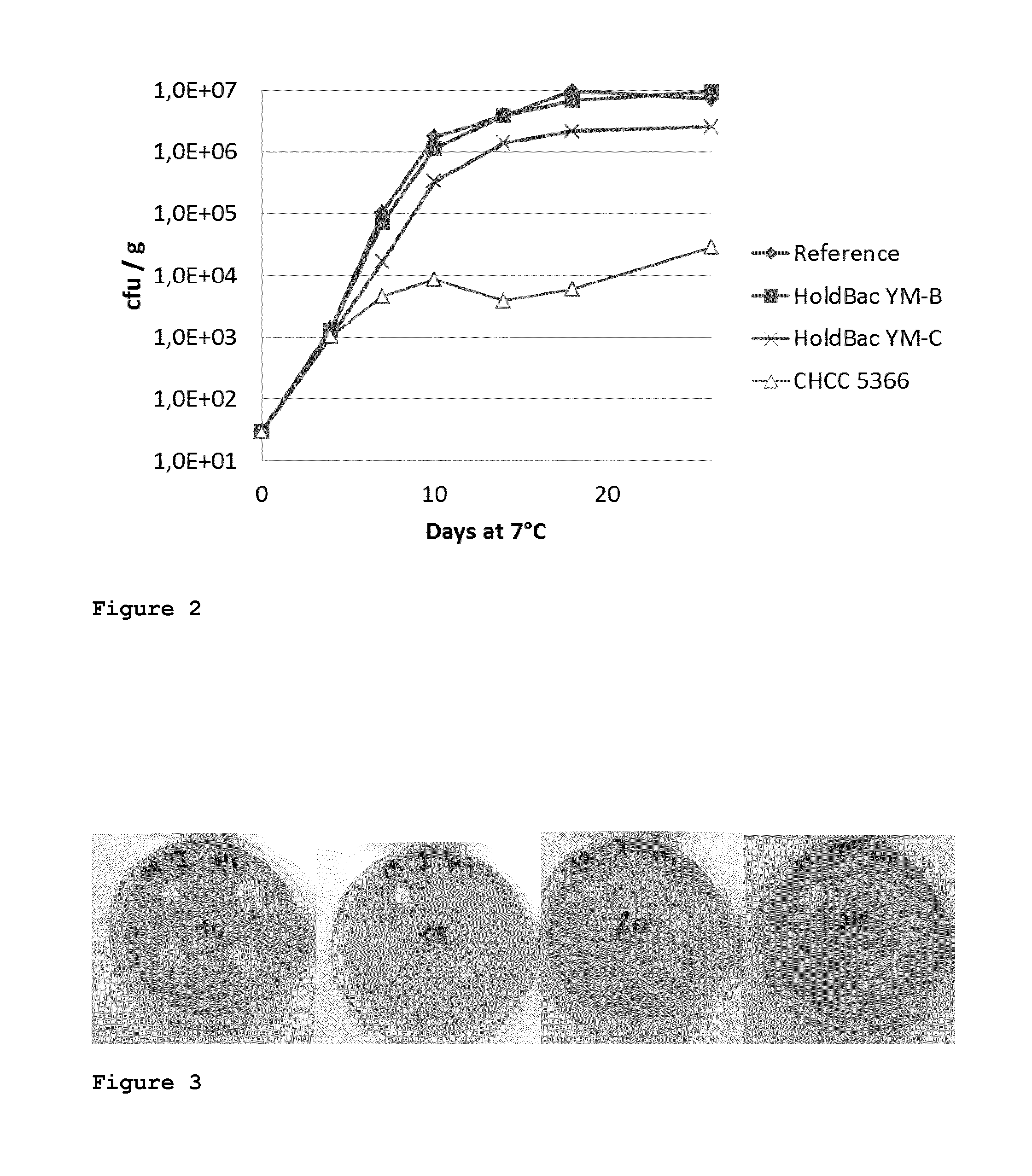Bioprotection using lactobacillus rhamnosus strains
- Summary
- Abstract
- Description
- Claims
- Application Information
AI Technical Summary
Benefits of technology
Problems solved by technology
Method used
Image
Examples
example 1
Challenge Study on Yoghurt with Lactobacillus rhamnosus CHCC5366
[0080]For the visual examination of the inhibitory effect of Lactobacillus rhamnosus strain CHCC5366 on the different molds, P. brevicompactum, P. commune, A. versicolor and P. crustosum, yoghurt with 1.5% fat was prepared:
[0081]Homogenized milk (1.5% fat) was heat-treated 95° C.±1° C. for 5 min. in 1 L bottles in a water bath and cooled immediately. A commercial starter culture (F-DVS YF-L901 obtainable from Chr. Hansen A / S, Denmark) was inoculated at 0.02%. The milk was further inoculated with HOLDBAC™ YM-B (20DCU / 100 L) or Lactobacillus rhamnosus CHCC5366 (1×107 CFU / ml) and one bottle was used as reference and only inoculated with starter culture.
[0082]The milk was fermented at 43° C.±1° C. until pH of 4.60±0.1 was reached. The resulting yoghurt was poured into cups (100 g) and stored at 7° C.±1° C.
[0083]One day after preparation of yoghurt different molds were inoculated as surface contaminants in duplicate cups of ...
example 2
Quantitative Determinations of the Inhibitory Effect of Lactobacillus rhamnosus CHCC5366 Against Debaromyces hansenii
[0085]For a quantitative examination of the inhibitory effect of Lactobacillus rhamnosus CHCC5366 on D. hansenii, yoghurt was prepared:
[0086]Homogenized milk (1.5% fat) was heat-treated at 95° C.±1° C. for 5 min. in 1 L bottles in a water bath. The milk was cooled immediately. Each bottle was inoculated with a commercial starter culture (F-DVS YF-L901 obtainable from Chr. Hansen A / S, Denmark) at 0.02%. The milk was further inoculated with HOLDBAC™ YM-B (20 DCU / 100 L) or HOLDBAC™ YM-C (10 DCU / 100 L) or Lactobacillus rhamnosus CHCC5366 (1×107 CFU / g) and one bottle was used as reference and only inoculated with starter culture.
[0087]The milk was fermented at 43° C.±1° C. until pH of 4.60±0.05 was reached. The resulting yoghurt was poured into cups (approx. 75 ml) and stored at 7° C.±1° C.
[0088]The day after preparing the yoghurt, the cups were inoculated in duplicate wi...
example 3
Semi-Quantitative Determinations of the Inhibitory Effect of Lb. Paracasei CHCC14676 and Lb. rhamnosus CHCC5366 Alone and in Combination Against Different Mold Contaminants
[0090]For the semi-quantitative examinations of Lb. paracasei CHCC14676 and Lb. rhamnosus CHCC5366 alone and in combination, an agar-assay was used, resembling the manufacturing process and product of yoghurt:
[0091]Homogenized milk (1.5% fat w / v) was heat-treated at 95° C. for five minutes and cooled immediately. A commercial starter culture (F-DVS YC-350 obtainable from Chr. Hansen A / S, Denmark) was inoculated at 0.02%, and the milk was distributed to 220 ml bottles. The bottles were further inoculated with Lb. paracasei CHCC14676, Lb. rhamnosus CHCC5366 and a combination of the two strains, respectively, in total concentrations of 1×107 CFU / ml. One bottle without further inoculation than starter culture was used as reference. Furthermore, 5% of a pH-indicator of bromcresol purple and bromcresol green was added t...
PUM
 Login to View More
Login to View More Abstract
Description
Claims
Application Information
 Login to View More
Login to View More - R&D
- Intellectual Property
- Life Sciences
- Materials
- Tech Scout
- Unparalleled Data Quality
- Higher Quality Content
- 60% Fewer Hallucinations
Browse by: Latest US Patents, China's latest patents, Technical Efficacy Thesaurus, Application Domain, Technology Topic, Popular Technical Reports.
© 2025 PatSnap. All rights reserved.Legal|Privacy policy|Modern Slavery Act Transparency Statement|Sitemap|About US| Contact US: help@patsnap.com



